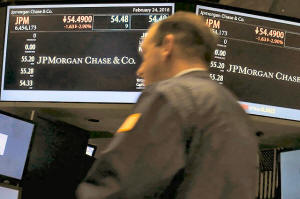|
U.S. bank stock gains may stall after
two-year rally
 Send a link to a friend
Send a link to a friend
 [May 18, 2018]
By Sinéad Carew [May 18, 2018]
By Sinéad Carew
(Reuters) - After two
years of sharp gains for U.S. bank stocks, investors betting on another
big boost for 2018 may be disappointed unless loan growth accelerates or
regulations slacken considerably.
The S&P 500 bank sector index <.SPXBK> beat first quarter earnings
estimates by 3.1 percent, and Wall Street's 2018 earnings growth
consensus for the sector climbed to 32.2 percent in early May from 28.4
percent on April 1, according to Thomson Reuters data.
But strength in trading revenue, net interest margins and lower tax
rates from legislation passed by the U.S. Congress in December, was not
enough to offset investor disappointment over the growth rate in bank
lending.
Despite better-than-expected profits, the S&P 500 bank index traded
sideways in the first few weeks of earnings season, which was kicked off
by JPMorgan Chase on April 13. As the broader market gained in early
May, the sector enjoyed a five-day rally to show a year-to-date gain of
1.2 percent, a far cry from the annual gains of 20 percent in both 2016
and 2017.
The S&P 1500 bank index <.SPCOMBKS> of small and mid-sized banks has
done slightly better than the bigger banks with a 2 percent year-to-date
increase. But it too pales beside 22 percent and 17 percent gains for
2016 and 2017, respectively.

Investors view the bank sector as a way to profit from rising interest
rates and economic growth. Some are betting on more gains in the sector,
hoping for improving loan demand, more profit growth from rising U.S.
interest rates and regulatory relief, such as looser lending, trading
and capital restrictions.
But others are skeptical banks have much more room to rise.
"It's hard to expect there's going to be some sort of home run for the
banks," said Frederick Cannon, director of research at Keefe Bruyette &
Woods.
"Higher rates are (priced) in the stocks. The tax bill is in the stocks.
The lighter regulatory touch, maybe we've already seen the benefits of
that," Cannon said.
A potential catalyst is accelerating loan growth, but that's not very
likely, he added.
ATTRACTIVE VALUATIONS?
Lisa Welch, portfolio manager at John Hancock Regional Bank Fund in
Boston, however, is expecting more gains for bank stocks, which she
believes are undervalued.
The S&P 500 bank index trades at 11.34 times earnings estimates for the
next 12 months compared with the historical mean of 12.56.
[to top of second column]
|

A trader works by the post where JPMorgan Chase & Co is traded on
the floor of New York Stock Exchange (NYSE) February 24, 2016.
REUTERS/Brendan McDermid

Welch also expects the 2010 Dodd Frank financial reform law to be
amended to raise the size of banks deemed "too big to fail," and thus
subject to tougher oversight. If this happens it could result in more
bank mergers and share gains.
"It's a sector that benefits from rising rates, a growing economy
and a more favorable regulatory environment that's trading at
attractive valuations," said Welch. She also pointed to indications
from bank executives during quarterly results conference calls that
loan growth would pick up.
But Michael Cronin, Equity Research Analyst at Aberdeen Standard
Investments in Boston, believes corporate tax cuts have actually put
a damper on loan growth by increasing the cash available to
companies to pay down existing debt or to invest.
He said a pickup in the overall pace of economic growth might be
needed to accelerate lending from current levels. Loans at the
biggest U.S. banks rose to $5.07 trillion in April from $5.05
trillion in March, while commercial and industrial loans rose to
$1.18 trillion in April from $1.16 trillion in March, according to
Federal Reserve data.
"What we'll continue to see is modest loan growth. I wouldn't expect
a big acceleration in the back half of 2018," Cronin said. "I'm not
sure I see a catalyst out there for it."
Charles Peabody, partner at Portales Partners in Chatham, New
Jersey, is optimistic that loan growth will expand if U.S. companies
continue to increase share buybacks and capital spending.[L1N1SE15G]
But he sees any stock gains from a lending expansion as short lived
because accelerated lending will increase credit costs.

"I don't expect stocks to fall out of bed tomorrow, but we're
putting in a top," Peabody said. "By the end of this year, when we
look back we'll see the first half of this year was" the peak.
(Reporting By Sinéad Carew)
[© 2018 Thomson Reuters. All rights
reserved.]
Copyright 2018 Reuters. All rights reserved. This material may not be published,
broadcast, rewritten or redistributed.
Thompson Reuters is solely responsible for this content. |